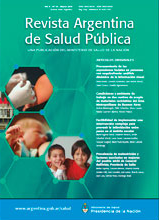Fishes for human consumption as indicators of environmental pollution by pesticides in northern Misiones, Argentina
Keywords:
Environment, Pollution, Fish, HealthAbstract
INTRODUCTION: The northern region of Misiones is characterized by a large area of small-scale crops, whose socio-environmental impact through use of pesticides has to be studied. The combination of crops and aquaculture in this region grew significantly as an income diversification mechanism. Through the use of fish for human consumption as indicator of pollution, this project aimed to determine environmental and health risks associated to inadequate land-use management practices. METHODS: Analyses of non-destructive biomarkers like differential leukocyte count, cholinesterase enzymatic activity and frequency of micronuclei in fish of the species Oreochromis niloticus were carried out. RESULTS: Alterations of the standard parameters tested on individuals from crop areas were determined and the level of lindane in sediment of the ponds in culture zone was detected. CONCLUSIONS: Although the multi-functional land management led to a more efficient use of natural resources, the exposure of fish to pesticides used on the crops has become an unintended consequence in this region.
Downloads
Downloads
Published
How to Cite
Issue
Section
License
Copyright (c) 2020 Revista Argentina de Salud Pública

This work is licensed under a Creative Commons Attribution-NonCommercial-ShareAlike 4.0 International License.


